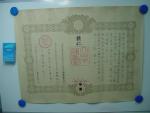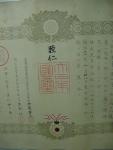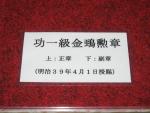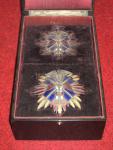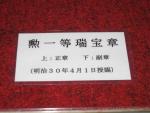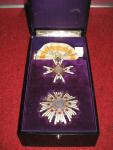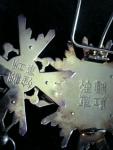-
Posts
1,751 -
Joined
-
Last visited
-
Days Won
3
Content Type
Profiles
Forums
Blogs
Gallery
Events
Store
Everything posted by Dieter3
-
Here's a wonderful 4th Class Meiji 11 (1878!) document, I'm sure a lot of you saw this one, but for those that may not have - this sold for around 93,000 yen/ $1100.00 U.S. - NICE. Wish it was mine!! The pics are from the auction, not the greatest as far as size goes, but here it is:
-
Indeed! Dr. Claw - your research assignment is before you! :lol:
-
Nice!! So, I wonder who the bloke is two back - looks like he might be wearing a Golden Kite around his neck, but I can't make out anything else. Quite a few medals though!
-
I know this is getting outside of the realm of rational possibility, but would this extend to a family member that had inherited a medal or must it literally be the recipient (like a really old veteran!)? Can they reissue say a Golden Kite, or is this limited to what is still current issue like the Rising Sun/Sacred Treasure?
-
Na, I just like crack-pot theories!! But seriously, you figure there must have been pieces that survived the war and such, NIB. I wouldn't think they'd want to waste them. I guess they could be scraped and recycled - but if they were perfectly good, why not issue them? I mean after all, they would have been new, just old stock. I don't lend much support for the theory actually, it was something to simply throw out there for people to chew on. YUM!! :)
-
Yes, I forgot to comment on this earlier - no marks in sight! So - we know that at least 4th-6th class Sacred Treasures with screws have the two-character code on the suspension. I do not know about 3rd class awards - can anybody confirm that they have these characters as well? I'm guessing they do, but would prefer confirmation. Maybe they simply don't mark the higher class awards for some reason, but it seems inconsistent to mark some and not others, no? Unless these are left-overs from the war-era, are you convinced yet? :rolleyes:
-
Well, I don't know - have modern pieces really changed shape or enameling that much from war-era pieces? I mean we're not talking left overs from the Meiji period!! I don't that the changes would be significant, if at all!!?? It is unlikely - but is it beyond the realm of remote possibility? Patina can be cleaned up! Hmmm. But for what reason? To see what methods worked better/faster/cheaper? Are we sure of this? I would think that branches would adopt identical construction techniques, especially post-war construction. It wouldn't surprise me if different branches used different methods and techniques, but why would they? Doesn't it make more sense to be uniform in the approach? When medals started to be re-issued, were they indeed made by multiple branches? I suppose they could have been tooled differently, but I'd expect a modernization of equipment by then to indeed be more uniform, unless they were running older equipment that simply didn't need upgrading?
-
Agreed! Not my cup of tea, but gotta admit - impressive!
-
AHHHH!!! The puzzle grows!! Agree - there must be concurrent existence of these multiple construction types - but why? I agree - not likely that these are mixed pieces. Now, correct me if I'm wrong - I thought when re-issuance began that all orders were made at the Japan Mint, no? If I'm mistaken - then yes, the differences could be explained by different manufacturers, but if I'm not mistaken then here is my theory: Pieces may have been left over from the war-era - stored somewhere - and why waste them? Why not continue issuing them? It might be a bit on the outside to assume that there would be many high class orders like 1st and 2nd (especially 1st!!) just sitting around - but I could see 3rd class and lower. Thoughts???
-

Applying the Golden Kite dating classification - a question for JapanX
Dieter3 replied to Paul L Murphy's topic in Japan
Ha! Didn't even notice that, good point! ;) -

Applying the Golden Kite dating classification - a question for JapanX
Dieter3 replied to Paul L Murphy's topic in Japan
Perhaps, but then why not display it like the Sacred Treasure one? I hope they have it! -

Applying the Golden Kite dating classification - a question for JapanX
Dieter3 replied to Paul L Murphy's topic in Japan
I wish the sash was availble for viewing (it may be gone actually) and the rosette! I am somewhat surprised that they do not better care for these items, but perhaps they wish to simply leave them untouched. Definitely one the Golden Kites worth a small fortune, but agree with you - PRICELESS!! Simply awesome really when you think about it and the incredible, incredible history behind it!! -

Making sense of it all - Sacred Treasures of known award date....
Dieter3 replied to Paul L Murphy's topic in Japan
Oh yes!! Must see!! Agreed! I've only seen and heard from others that these are on screw-type pieces. But this makes me curious - so we know some awards like posted above that are issued during this same time period - do they have this coding, like 3rd class, etc.?? I wonder.... -

Applying the Golden Kite dating classification - a question for JapanX
Dieter3 replied to Paul L Murphy's topic in Japan
For Nick's analysis, Genral Nogi's Golden Kite. Sorry Nick, picture is not very good! What do you think? -

Making sense of it all - Sacred Treasures of known award date....
Dieter3 replied to Paul L Murphy's topic in Japan
-

Making sense of it all - Sacred Treasures of known award date....
Dieter3 replied to Paul L Murphy's topic in Japan
Unfortunately, could not be fully photographed for obvious reasons - 1st Class as awarded to General Nogi on April 1st, 1897. I think think this counts as a known-dated award! I think I posted this elsewhere, but I'll add it here again to support this thread..... -
I think you meant Showa 33. 1958! :)
-
Rich, I can certainly understand how that must feel. I don't think a lot of people can truly appreciate the time and effort that you (and many others here!) have put into doing the research that you do, not to mention the exceptional costs ivnvolved with simply collecting the material to begin with! None of this has come easy. To not even say a simply "thank you" though, that's sort of beyond measure. Just know though that your efforts do not go wholy unappreciated! :)
-
Absolutely!! And thank you again, this kind of info just makes things all the more complete. On that - how are the dark blue medal rolls presented? My guess is too numerous to do a page on each recipient like the other ones. Are they more a summary by date? For a given date, the following people were awarded....., or something like that? Something else that surprises me is why more presentation documents don't show up, at least for thre dark blue ribbon - they aren't exactly rare, but the documents seem fairly scarce.
-

Making sense of it all - Sacred Treasures of known award date....
Dieter3 replied to Paul L Murphy's topic in Japan
From a current auction - 1st Class, 1985 - also with PM Nakasone's name, like Pieter2012's 4th class, but two years later. These pictures are nearly worthless. Considering the prices, it always staggers the mind (at least mine) that sellers use such low-rent photos, and so few. http://gmic.co.uk/uploads/monthly_01_2012/post-6375-0-41665300-1326601045.jpghttp://gmic.co.uk/uploads/monthly_01_2012/post-6375-0-80620600-1326601053.jpghttp://gmic.co.uk/uploads/monthly_01_2012/post-6375-0-48938900-1326601055.jpg Anyway - this piece, if we believe it to be matched, and I have no reason to believe otherwise - shows us that clearly two methods of construction were used simultaneously - screws and rivets - the question is why? Granted - the difference is between a 4th and a 1st Class piece. Perhaps 1st class pieces have ALWAYS been riveted like this. 3rd Class pieces have clearly been shown to have the non-rivet, and non-screw type construction - just the plain - but where in time must they fit? Could they also have been mixed with the riveted type like Paul's 1963? Are they later? More on my latest crackpot theory soon..... :lol: -

Making sense of it all - Sacred Treasures of known award date....
Dieter3 replied to Paul L Murphy's topic in Japan
Paul, do any of your know-date later issues have any maker's marks or a code like Pieter's 4th, or other pieces of 80s, 90s issue?? -
Well, it would at least appear that the oval clasp with the mirror on it is earlier tan 1920!!
-

Making sense of it all - Sacred Treasures of known award date....
Dieter3 replied to Paul L Murphy's topic in Japan
Interesting, interesting. I wonder at what point in time the mint began to reuse hallmarks/codes on the suspension knobs, and what the heck do they mean?? -
Nice photos! Now we need to see more of these types with documents. Wish I could contribute to that! Somewhere, there must be written information about this design and then the subsequent changes. Somewhere.....



